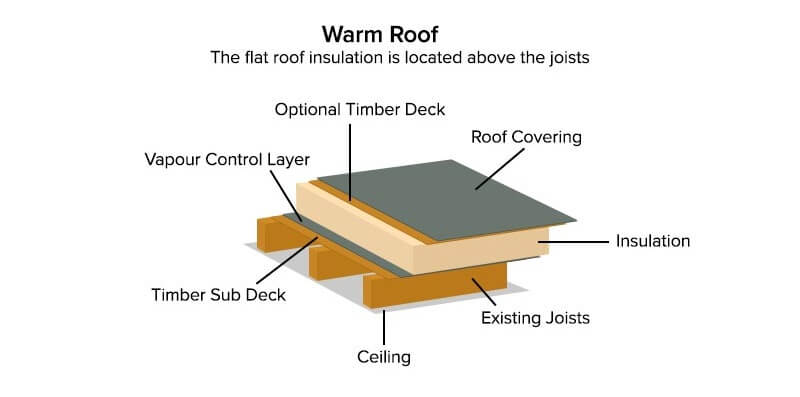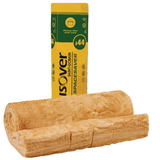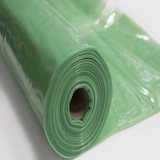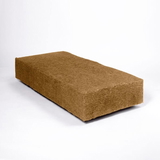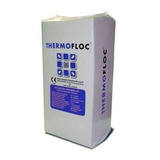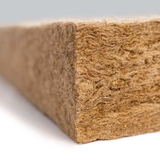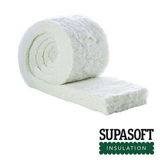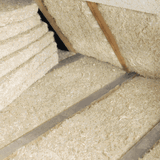- Blogs
- Understanding The Difference Between A Warm Roof And A Cold Roof
Understanding The Difference Between A Warm Roof And A Cold Roof

Roofing systems can be categorised into two main types: warm roofs and cold roofs. However, many people find it confusing to differentiate between the two. In this article, we will explore the distinction between warm roofs and cold roofs to provide a clearer understanding. We will also discuss the importance of roof insulation, ventilation, and vapour barriers in each roof type.
Warm Roofs:![]()
A warm roof is a type of roofing system where the insulation is placed on top of the roof structure, within the heated area of the building. In this configuration, the insulation acts as a barrier, preventing the cold air from penetrating the roof and maintaining the underside of the roof as part of the heated space. Warm roofs are commonly used in situations where unlimited height is available and space allows for the insulation to be positioned on top of the roof.
One of the primary advantages of warm roofs is their effectiveness in preventing condensation. As airborne moisture rises through the plasterboard, it encounters the warm underside of the insulation. Since the insulation acts as a barrier, the moisture does not reach the cold roof deck, where it could potentially condense and cause problems such as rot and structural damage.
To ensure effective insulation and prevent moisture migration, vapour barriers are crucial components of warm roofs. These barriers are installed on the warm side of the insulation, typically beneath the decking material. The vapour barrier acts as an additional layer of protection, preventing moisture from reaching the deck and further reducing the risk of condensation-related issues.
Cold Roofs:![]()
In contrast, a cold roof is a roofing system where the insulation is placed within the joists, creating a void between the insulation and the roof deck. Cold roofs are often utilised in situations where limited height is available, or when planning restrictions or neighbour concerns prevent the roof from being built to its full height.
While cold roofs provide practical solutions in terms of limited space, they require careful consideration to mitigate condensation risks. The absence of insulation on top of the roof means that airborne moisture can penetrate the insulation and reach the cold side, where it can condense and cause damage. It is essential to address this by implementing effective ventilation in cold roofs.
Ventilation is crucial in cold roofs to create a through-flow of air within the roof void. This ventilation helps remove any trapped moisture and reduces the risk of condensation-related problems. The recommended minimum airspace for ventilation is 50mm, providing a pathway for moisture to escape. Ventilation can be achieved through soffit ventilators at the front, and various methods such as over tile vents or mushrooms at the back of the roof.
It is also worth noting that vapour barriers are necessary for cold roofs to control the migration of moisture. Installing a vapour barrier beneath the insulation prevents moisture from reaching the roof deck and further reduces the risk of condensation.
Warm Roofs Vs Cold Roofs:
When choosing between a warm roof and a cold roof, it's important to consider the advantages and drawbacks of each. The primary benefit of a warm roof is its effectiveness in preventing condensation, as the insulation, positioned on top of the roof structure, acts as a barrier against cold air. Warm roofs are suitable for buildings where there's unrestricted height available for the insulation.
On the downside, warm roofs can be more expensive to install due to the amount of insulation needed, and they may also require regular maintenance to ensure that the vapour barrier and insulation are performing effectively. In addition, in buildings where height is a limiting factor, it might not be feasible to use a warm roof system.
Cold roofs, meanwhile, are often the go-to option for buildings with height restrictions. They can also be more cost-effective due to the lesser insulation used. However, cold roofs present a greater risk of condensation issues as the insulation is positioned within the joists, leaving a cold void at the top. Therefore, careful planning and implementation of effective ventilation are essential when opting for a cold roof.
Performance Comparison:
In terms of energy efficiency, warm roof insulation is typically more effective than cold roof insulation as the insulation is positioned on top of the roof structure, which retains the heat within the building. As a result, warm roofs can contribute to lower energy costs in the long term.
On the other hand, cold roofs, with their insulation placed within the joists, can experience heat loss due to the exposed roof deck. This can lead to higher energy costs. However, with proper insulation, a cold roof can also offer decent energy efficiency.
In terms of structural protection, both warm roofs and cold roofs have their merits, provided they are installed correctly with the necessary components: insulation, ventilation, and vapour barriers.
A Case Study:
To further illustrate the distinction between warm roofs and cold roofs, let's consider a case study of a residential building.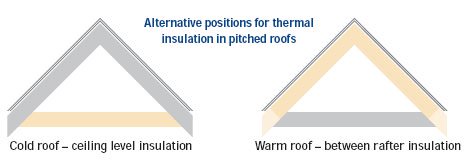
In a home located in a region with harsh winters and mild summers, a warm roof system was chosen. This choice allowed the homeowners to effectively prevent condensation and retain indoor heat, which is crucial in their cold climate. The insulation layer placed on top of the roof structure ensured the interior was kept warm, thereby increasing the building's overall energy efficiency. To ensure optimal performance, a vapour barrier was installed beneath the decking material, preventing moisture migration.
In contrast, a house located in an area with mild winters and height restrictions opted for a cold roof system. The homeowners implemented effective ventilation through soffit ventilators and over tile vents, ensuring a through-flow of air to remove any trapped moisture. Although this choice required more maintenance to prevent condensation issues, it was necessary due to the height limitations imposed by the local planning authorities.
The implementation of both warm and cold roofs in these different scenarios underscores the importance of understanding their differences, benefits, and drawbacks.
Key Takeaway: Understanding the difference between warm roofs and cold roofs is crucial for ensuring the long-term integrity and energy efficiency of buildings. Warm roofs have insulation on top of the roof structure, preventing condensation by keeping the underside warm. Cold roofs, on the other hand, feature insulation within the joists, requiring effective ventilation to remove any trapped moisture. Both warm roofs and cold roofs can be successfully implemented with the proper insulation, ventilation, and vapour barriers.
Frequently Asked Questions
Can I convert a warm roof into a cold roof?
While it is possible to convert a warm roof into a cold roof, it requires careful planning and consideration. Consult a professional to assess if the conversion is feasible and what modifications are needed to ensure proper insulation and ventilation.
How does condensation affect roofs?
Condensation can lead to moisture buildup, which, in turn, can cause rot, mould growth, and damage to the roof structure. Proper insulation, ventilation, and the use of vapour barriers are essential to mitigate condensation-related problems.
Are there any alternatives to ventilation in cold roofs?
Ventilation is the recommended solution for cold roofs to prevent moisture accumulation. However, other measures, such as drilling holes through joists, can provide limited ventilation. It is crucial to strike a balance between ventilation and maintaining the structural integrity of the joists.
Can downlighters affect roof moisture levels?
Yes, downlighters can impact moisture levels in roofs if proper precautions are not taken. It is advised to use downlighters that allow the installation of vapour-checked barriers over them to maintain a complete seal and prevent the entry of moisture.
What are the essential components of a warm roof?
Warm roofs require insulation on top of the roof structure to keep the underside warm. Additionally, a vapour barrier is necessary to prevent moisture from migrating through the insulation and causing condensation-related issues.
How can ventilation be achieved in a cold roof?
Ventilation is crucial in cold roofs to create a through-flow of air that can remove any trapped moisture. It can be achieved through soffit ventilators at the front and various methods, such as over tile vents or mushrooms, at the back. These measures ensure a healthy and dry environment within the roof void.
Why are vapour barriers important in both warm roofs and cold roofs?
Vapour barriers are necessary to control the migration of moisture. In warm roofs, they prevent moisture from reaching the roof deck, while in cold roofs, they reduce the risk of condensation by preventing moisture from reaching the roof deck and causing damage.
In Conclusion
By understanding the distinct characteristics of warm roofs and cold roofs, along with their individual strengths and weaknesses, you are equipped to make informed decisions for your construction or renovation project.
For top-quality roof insulation visit Buy Insulation Online. We stock vapour barriers and a whole range of insulation supplies that will help you achieve effective warm or cold roof insulation at a low cost!

Samuel Hitch
Managing Director
Buy Insulation Online.
Leave A Reply
Your feedback is greatly appreciated, please comment on our content below. Your email address will not be published. Required fields are marked *
